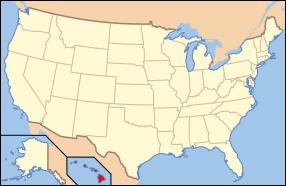Hawaii
Koordinat: 21°18′41″N 157°47′47″W / 21.31139°N 157.79639°W
| Nagara Bagian Hawaii State of Hawaii Mokuʻāina o Hawaiʻi | |||||||||||
| |||||||||||
| Basa resmi | basa Inggris, basa Hawaii | ||||||||||
| Démonim | Hawaiian (tempo catetan)[1] | ||||||||||
| Ibu kota | Honolulu | ||||||||||
| Kota panggedéna | Honolulu | ||||||||||
| Area | Réngking ka-43 di AS | ||||||||||
| - Total | 10.931 sq mi (28.311 km²) | ||||||||||
| - Rubak | n/a miles (n/a km) | ||||||||||
| - Panjang | 1.522 miles (2.450 km) | ||||||||||
| - % cai | 41,2 | ||||||||||
| - Latitud | 18° 55′ N to 28° 27′ N | ||||||||||
| - Longitud | 154° 48′ W to 178° 22′ W | ||||||||||
| Populasi | Ranked ka-40 in the US | ||||||||||
| - Total | 1.360.301 (Sénsus 2010)[2] 1.211.537 (2000) | ||||||||||
| - Kapadetan | 188,6/sq mi (72,83/km²) Ranked ka-13 in the US | ||||||||||
| - Median income | $63.746 (ka-5) | ||||||||||
| Élevasi | |||||||||||
| - Titik pangluhurna | Mauna Kea[3][4][5][6] 13.803 ft (4207,3 m) | ||||||||||
| - Rata-rata | 3.030 ft (920 m) | ||||||||||
| - Titik panghandapna | Samudra Pasifik[4] 0 ft (0 m) | ||||||||||
| Ditarima ku Sarikat | 21 Agustus 1959 (ka-50) | ||||||||||
| Gubernur | Neil Abercrombie | ||||||||||
| Letnan Gubernur | Brian Schatz | ||||||||||
| Senator AS | Daniel Inouye Daniel Akaka | ||||||||||
| Delegasi Kongrés | 1: Colleen Hanabusa (D) 2: Mazie Hirono (D) (daptar) | ||||||||||
| Zona wanci | Zona Wanci Hawaii-Aleut: UTC-10 (euweuh DST) | ||||||||||
| Singgetan | HI US-HI | ||||||||||
| Loka ramat | www.hawaii.gov | ||||||||||
Hawaii (basa Hawaii: Mokuʻāina o Hawaiʻi) mangrupa nagara bagian Amérika Sarikat ka-50 (ti 21 Agustus 1959), jeung sahiji-hijina nagara bagian AS nu diwangun sapinuhna ku kapuloan. Hawaii mangrupa grup kapuloan nu pangkalérna di Polinésia. Ibu kotana nyaéta Honolulu, aya di pulo Oʻahu.
Étimologi[édit | édit sumber]
Kecap basa Hawaii Hawaiʻi diturunkeun ti Proto-Polinésia *Sawaiki, kalawan rékonstruksi nu boga harti "lemah cai";[7] Kognat Hawaiʻi dipanggih di rupa-rupa basa Polinésia nu lian, kaasup Māori (Hawaiki), Rarotonga (ʻAvaiki), jeung Samoa (Savaiʻi).
Dumasar Pukui jeung Elbert,[8] "Di tempat lian di Polinésia, Hawaiʻi atawa kognatna boga harti alam baka atawa bumi sepuh, tapi di Hawaiʻi, teu boga harti nanaon."[9]
Tempo ogé[édit | édit sumber]
Réferénsi[édit | édit sumber]
- ↑ Local usage generally reserves Hawaiian as an ethnonym referring to Native Hawaiians. Hawaii resident or islander is the preferred local form to refer to state residents in general regardless of ethnicity. The Associated Press Stylebook, 42nd ed. (2007), also prescribes this usage (p. 112).
- ↑ "Annual Estimates of the Resident Population for the United States, Regions, States, and Puerto Rico: April 1, 2000 to July 1, 2008". United States Census Bureau. Diakses tanggal February 6, 2009.
- ↑ Citakan:Cite ngs
- ↑ a b "Elevations and Distances in the United States". United States Geological Survey. 2001. Diakses tanggal October 21, 2011. Archived Juli 22, 2012, di Wayback Machine
- ↑ Elevation adjusted to North American Vertical Datum of 1988.
- ↑ The summit of Mauna Kea is the highest point in Oceania. Mauna Kea is also the tallest mountain on Earth as measured from base to summit. The shield volcano sits on the floor of the Pacific Ocean at a depth of 5,998 meters (19,678 ft) for a total height of 10,205.3 meters (33,482 ft)
- ↑ Pollex—a reconstruction of the Proto-Polynesian lexicon, Biggs and Clark, 1994. The asterisk preceding the word signifies that it is a reconstructed word form.
- ↑ Pukui and Elbert 1986, p. 62.
- ↑ Pukui, Elbert, and Mookini 1974.
Bacaan salajengna[édit | édit sumber]
- The Constitution of the State of Hawaii. Article XV.
- Bushnell, O. A. 1993. The Gifts of Civilization: Germs and Genocide in Hawaii. ISBN 0824814576. Honolulu: University of Hawaii Press
- Kinzer, Stephen 2007, Overthrow: America's Century of Regime Change from Hawaii to Iraq. ISBN 0805082409. Times Books
- Lyovin, Anatole V. (1997). An Introduction to the Languages of the World. New York: Oxford University Press, Inc. ISBN 0-19-508116-1.
- Pukui, Mary Kawena; Samuel H. Elbert (1986). Hawaiian Dictionary. Honolulu: University of Hawaii Press. ISBN 0-8248-0703-0.
- Schamel, Wynell and Charles E. Schamel. "The 1897 Petition Against the Annexation of Hawaii." Social Education 63, 7 (November/December 1999): 402–408.
- Stokes, John F.G. 1932. "Spaniard and the Sweet Potato in Hawaii and Hawaiian-American Contacts." American Anthropologist, New Series, v, 34, n, 4, pp. 594–600.
Tumbu kaluar[édit | édit sumber]
| Pék paluruh émbaran nu leuwih loba ngeunaan Hawaii ku jalan nyungsi proyék sabaraya Wikipédia | |
|---|---|
| Définisi kamus ti Wiktionary | |
| Buku téks ti Wikibooks | |
| Cutatan ti Wikiquote | |
| Téks sumber ti Wikisource | |
| Gambar jeung média ti Commons | |
| Warta ti Wikinews | |
| Sumber pangajaran ti Wikiversity | |
![]() Tempo ogé Hawaii di Wikivoyage
Tempo ogé Hawaii di Wikivoyage
- Hawaii State Fact Sheet Archived 2011-10-04 di Wayback Machine ti Departemén Agrikultur AS
| ||||||||||||||
| ||||||||||||||||||||||||||||||
| ||||||||||
| Artikel ngeunaan géografi ti hiji nagara atawa wewengkon ieu mangrupa taratas, perlu disampurnakeun. Upami sadérék uninga langkung paos perkawis ieu, dihaturan kanggo ngalengkepan. |




